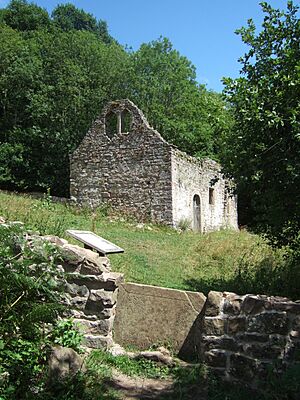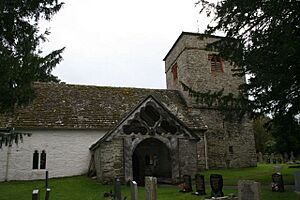Cewydd facts for kids
Saint Cewydd was an early Welsh saint from the 6th century. He lived during the time known as the Early Middle Ages in Wales. Saint Cewydd is often called the Welsh 'Rain Saint'. This is similar to other saints like Saint Medard in France or Saint Swithin in England. People believed that if it rained on his special day in July, it would keep raining for forty more days!
Contents
Who Was Saint Cewydd?
Not much is known about Saint Cewydd's life. This is because there are very few written records from the early Dark Ages in Wales. Most of what we know comes from the churches named after him. These churches show us where he might have traveled or where his followers lived.
Places Connected to Saint Cewydd
Churches named after Saint Cewydd can be found in many places. These include:
- Anglesey in Wales
- Lancaut near Chepstow, on the border of Wales and England
- Cusop, also on the Wales/England border
- Kewstoke in Somerset, England
- Steynton in Pembrokeshire, Wales
- Aberedw in Radnorshire, Wales
- Disserth yn Elfael in Radnorshire, Wales
- Llangewydd and Laleston near Bridgend, Wales
- Capel Cewy in Mynachlogddu, Pembrokeshire, Wales
Early Religious Sites
Old church records, like those in the Book of Llandaff, mention a religious place called lann ceuid. This place was probably at Lancaut. It seems to have been set up around the year 625 AD. It was still recorded there by 703 AD. This shows that Saint Cewydd's influence was felt early on.
When Do We Celebrate Saint Cewydd?
Saint Cewydd's special day, or feast day, is usually celebrated on July 1st. However, in South Wales, there is a tradition that celebrates him on July 15th. This day is called Dygwyl Cewydd, which means Feast of St Cewydd. Before changes to the calendar, this day was celebrated on July 2nd.



